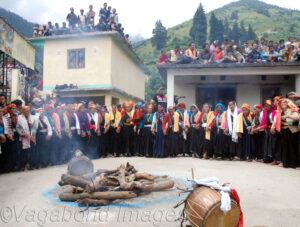
Uttarakhand, a place rich in culture, is reflected in the various dance forms and folk songs performed in this region. The folk dances of Uttarakhand are varied in nature and style and are mostly performed during various functions, festivals, and occasions.
These dance forms are not difficult to learn and perform, but they require highly rhythmic synchronicity to make them a sight to behold. Both males and females gather to perform for the sake of appeasing the gods and goddesses and believe that if the dance is not performed properly, then the gods will be dissatisfied. They perform it while dressing up in traditional attire, which is eccentric and colourful in its own right and whose beauty and design appeal to the people of other regions.
The folk dance originated in the ancient eras and has been evolving. According to the locals, the dancers possess the souls and spirits of young, unmarried girls who died with no funeral rites, believed to be the daughters of Ravana, who offered them to Lord Shiva as his handmaidens. However, some believe that they are linked to the Krishna legend by making them gopis who dance the ‘dance celestial’ with their lord.
These dance forms are varied in style and nature and are not only a mere form of artistic expression but also a means of preserving the stories, rituals, and way of life of the local communities. ‘Pandya Nritya’ is the most famous and highly performed folk dance, basically a narrative of the epic, the Mahabharata retelling the stories of the Pandavas through graceful movements and expressions. It is a 10- to 12-day dance-drama celebration performed between November and February every year. It is a spiritual art form where it is believed that the spirits of the Pandavas enter the bodies of performers, and on the last day it, a grand feast is organized for the villagers.

The dance is not performed only during the festivals but is also believed to be part of cremation rituals. In the ‘Bhotia Dance’ or; dance of the dead, the bhotia tribe commonly believes that the souls of the dead live in the body of a sheep or a goat after the human body dies. By performing this dance, the soul of the dead can be liberated from the animal’s body.
However, some exceptional dance forms require the participation of men only, such as the ‘choliya’ dance form, which represents the martial arts tradition of the Kumaon region. It is an ancient dance form that is particularly performed during the marriage ceremonies of the Rajputs. These dancers are equipped with swords and shields and regional brass instruments, including Turi and Ransing with dhol and damaru. These dancers put on the attire of Kumaoni warriors and engage in mock sword fights with synchronized twists and turns of the body.
Another is the ‘Langvir Nritya’ which originated in the Chamoli district of Uttarakhand. This is a highly male performance art form famous for its acrobatic moves, which require a high level of physical preparedness and agility. It involves acts like balancing on top of a pole or hanging from a rope while performing intricate dance moves. The dancers are dressed in conventional garb such as dhoti, turban, and waistcoat and use the dhol, nagara, and shehnai to play music.
This dance form is a testament to strength and flexibility.
The folk dance also represents the eradication of caste differences, which is symbolised through the ‘jhora’ form of dance, in which all the caste barriers disappear. This form is performed during the spring, mostly at fairs and sometimes to celebrate weddings. The men and women dance in a circle, holding each other’s arms and slightly bending their bodies forward as they move.
Apart from these, there are several other forms of folk dance, such as thali, Jadda, Jhainta, shotiya, Chancheri, and so on.
The folk dances take centre stage, captivating the audiences with their grace, energy, and way of storytelling. The vibrance of the cultural tradition attracts the attention of the majority of the population unfamiliar with it, making them feel stunned. Nevertheless, the significance of these forms of dance is slightly eradicated by becoming less popular among the new generation, who, after a certain point, leave their villages and migrate to cities for better opportunities and living standards, and the folk dance section is transiting itself under the influence of modern and advanced levels of dance forms and changing people’s choices in art.

